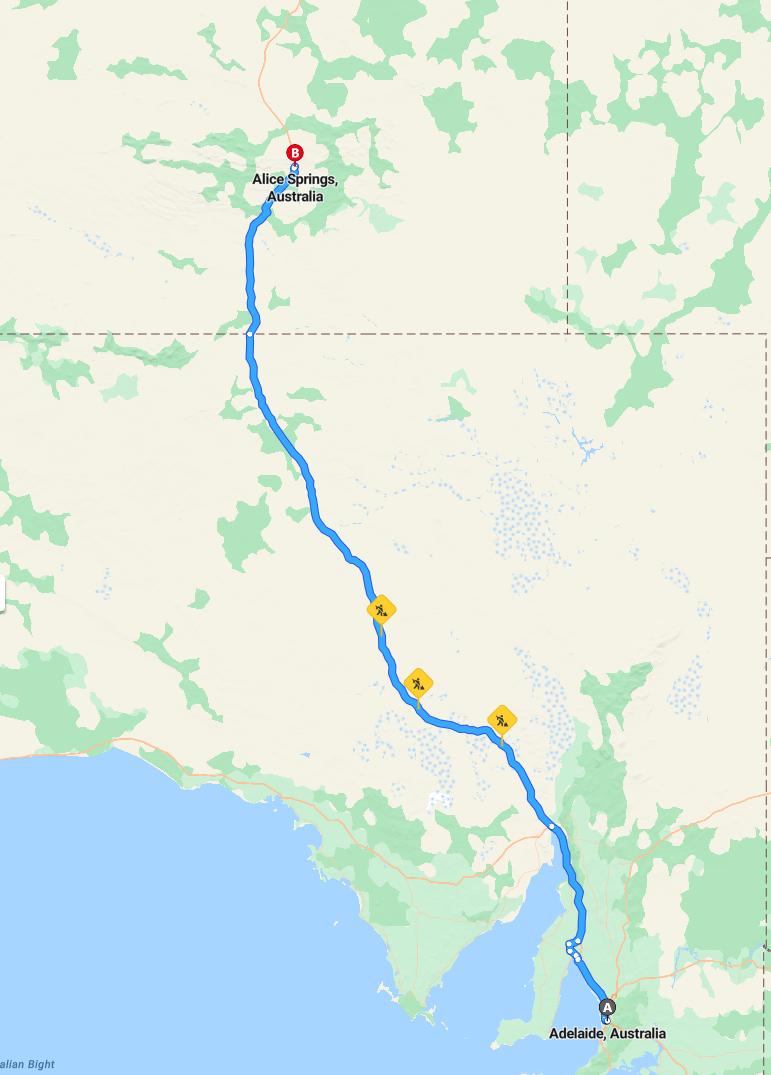Distance and estimated driving time
Driving from Adelaide to Alice Springs covers approximately 961 miles via Augusta Highway and Stuart Highway, offering a scenic route through the heart of Australia. The journey is estimated to take around 14 hours and 49 minutes, depending on traffic and road conditions. This long-distance trip provides travelers with an opportunity to experience diverse landscapes, from arid deserts to vibrant outback towns. Planning ahead for fuel, rest stops, and accommodations is essential to ensure a safe and enjoyable adventure along this iconic route.
Driving route
Embarking on a road trip from Adelaide to Alice Springs offers a unique adventure through the heart of Australia's outback. Starting in Adelaide, travelers can enjoy its vibrant cultural scene before heading north towards Marla, a small border town offering essential services. Continuing eastward, the journey takes you through the iconic opal mining town of Coober Pedy, famous for its underground dwellings and unique landscape. The route then passes through Erldunda, a key resupply point located at the gateway to Central Australia. Finally, the journey concludes in Alice Springs, a vibrant town rich in Aboriginal history and serving as a gateway to exploring the Australian desert.

Road conditions and safety tips
Driving from Adelaide to Alice Springs involves traversing remote and varied terrain, so it's essential to be prepared for changing road conditions. The highway generally offers well-maintained roads, but drivers should remain alert for potential obstacles such as wildlife, especially near Marla and Coober Pedy, and be cautious in remote areas like Erldunda. Ensuring your vehicle is in good condition, carrying extra fuel, water, and emergency supplies is vital for safety, given the long distances between stops. Additionally, adhering to speed limits, taking regular breaks, and staying updated on weather conditions will help ensure a safe and enjoyable journey through the Australian outback.
Best departure times and breaks
When planning a drive from Adelaide to Alice Springs, it is best to depart early in the morning around sunrise to maximize daylight hours for the journey. Taking regular breaks, approximately every 2 to 3 hours, is essential to stay alert and refreshed, especially given the long distance and remote terrain. Key stopping points like Marla and Coober Pedy provide convenient rest areas and opportunities to explore unique attractions, making breaks enjoyable. Ensuring adequate rest and timely departures will make the trip safer and more enjoyable, allowing travelers to appreciate the scenic landscapes along the route.
Vehicle preparation and maintenance
Before embarking on the Adelaide to Alice Springs journey, it is essential to thoroughly prepare your vehicle to ensure a safe and smooth trip. Check and top up essential fluids such as oil, coolant, and windshield wash to prevent breakdowns in remote areas. Inspect tires for proper pressure and tread wear, and carry spare tires and necessary repair tools. Additionally, ensure your vehicle's brakes, lights, and battery are in optimal condition, as service facilities can be sparse along the route through Marla, Coober Pedy, and Erldunda.
Fuel stations and availability
Traveling from Adelaide to Alice Springs, fuel stations are strategically located along the route, ensuring you can maintain a full tank throughout your journey. Key stops such as Coober Pedy, Erldunda, and Marla provide reliable fuel availability, with most stations offering essential services like snacks and rest areas. It is advisable to refuel at major towns to avoid running low in more remote stretches, particularly in the vast Outback areas. Planning your fuel stops in advance will help ensure a smooth drive, offering peace of mind as you explore the iconic Australian landscape.
Scenic spots and sightseeing stops
Traveling from Adelaide to Alice Springs offers a variety of captivating scenic spots and sightseeing opportunities. Starting in Adelaide, travelers can enjoy the vibrant cityscape and nearby parks, then explore Marla's vast outback vistas. The journey continues through Coober Pedy, famous for its surreal underground dwellings and unique Moon Plain landscape, providing a fascinating glimpse into underground living. Finally, Erldunda serves as a scenic gateway with views of the iconic Australian desert, culminating in Alice Springs, where striking red rock formations and Aboriginal cultural sites await exploration.
Accommodation options along the route
Travelers journeying from Adelaide to Alice Springs will find a variety of accommodation options along the route, ensuring a comfortable stay at each stop. In Marla, there are budget-friendly motels and caravan parks ideal for quick rest breaks. Coober Pedy offers unique underground hotels and charming bed-and-breakfasts that provide an authentic outback experience. Near Erldunda, travelers can choose from family-friendly motels and lodges, while Alice Springs boasts a wide range of accommodations, from luxury resorts to cozy hostels, catering to all preferences and budgets.
Local regulations and driving laws
When driving from Adelaide to Alice Springs, travelers must adhere to local regulations and driving laws specific to South Australia and the Northern Territory. Speed limits are strictly enforced, with variances depending on rural or urban areas, and it is essential to observe posted signs to avoid fines or penalties. Mobile phone use while driving is prohibited unless using a hands-free device, ensuring driver distraction is minimized. Additionally, travelers should be aware of unique conditions such as wildlife crossings, especially near Marla and Coober Pedy, and carry sufficient water and emergency supplies, as some stretches between towns can be remote and isolated.
Weather conditions and seasonal considerations
Traveling from Adelaide to Alice Springs, travelers should be mindful of the varying weather conditions and seasonal considerations along the route. Summers can bring extreme heat, especially around Coober Pedy, with temperatures soaring well above 40degC, making early morning travel preferable to avoid heat-related issues. Winters tend to be milder, with cooler mornings and evenings, but daytime temperatures remain comfortable for driving and outdoor activities. Additionally, seasonal rainfall can impact certain stretches of the route, so checking local weather forecasts before departure ensures a safe and enjoyable journey through this remote desert landscape.
